November 6, 2024 · 11 min read
Connecting Faculty and Administration Through AI-Powered Meetings

Shaimaa Badawi
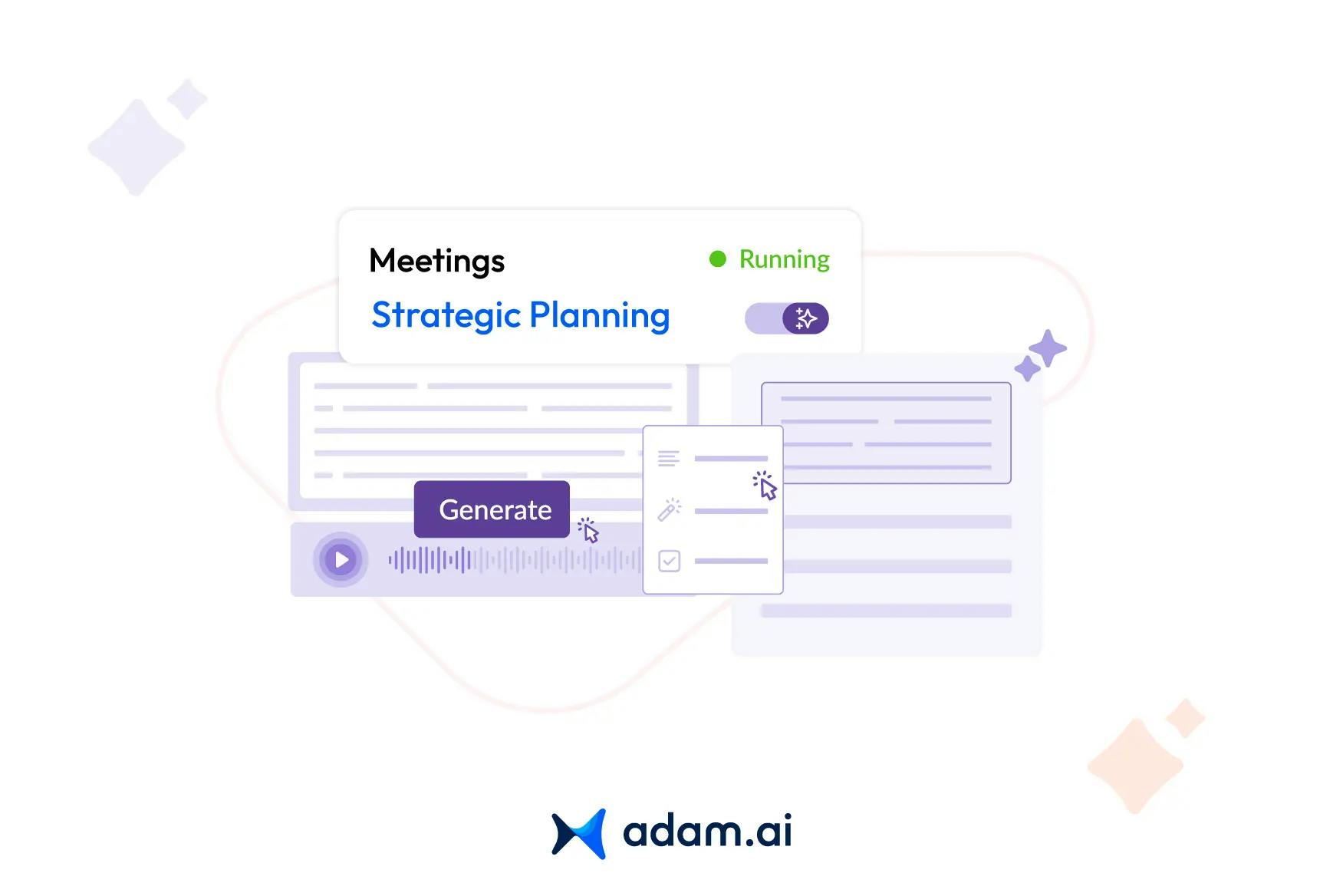
Collaboration between faculty and administration is at the heart of a thriving educational institution. Yet, aligning these two essential groups often feels like navigating opposing priorities. With the rise of AI-powered tools, bridging these gaps is no longer a daunting task but an achievable goal. This article explores how innovative meeting technologies not only enhance communication but also foster a more collaborative and productive academic environment.
Why is effective collaboration between faculty and administration important?
Effective collaboration between faculty and administration is the cornerstone of a well-functioning educational institution. Faculty members focus on teaching, research, and student engagement, while administrators manage policies, resources, and operations. Without alignment between these roles, institutions risk inefficiencies, misunderstandings, and a lack of unified vision.
When faculty and administration collaborate effectively, several outcomes emerge. First, decision-making becomes more inclusive, with diverse perspectives ensuring that policies and strategies address both academic and operational needs. This enhances the institution’s ability to adapt to challenges, such as integrating new technologies or addressing student concerns.
Second, collaboration fosters a shared commitment to institutional goals, such as improving student outcomes, enhancing research capabilities, and maintaining accreditation standards. This alignment ensures that faculty and administration work toward common objectives rather than operating in silos.
Finally, strong collaboration contributes to a positive campus culture. Mutual trust and respect between these groups encourage open communication, reduce conflicts, and create an environment where both faculty and administrators feel valued and supported in their roles. Institutions that prioritize collaboration ultimately foster innovation, resilience, and success in achieving their mission.
What challenges exist in faculty-administration collaboration?
Collaboration between faculty and administration often faces unique challenges due to differences in priorities, communication styles, and expectations. These challenges can disrupt alignment and hinder institutional progress. Here are the most common obstacles:
1. Diverging goals
Faculty primarily focus on teaching, research, and student outcomes, while administration emphasizes institutional policies, budget management, and operational efficiency. These differing priorities can create friction when decisions favor one side over the other.
2. Communication gaps
Miscommunication or lack of clear channels often leads to misunderstandings. Faculty may feel excluded from policy discussions, while administrators may perceive faculty as resistant to change.
3. Time constraints
Both groups operate under significant time pressures. Faculty juggle teaching and research duties, while administrators manage complex institutional operations. This limits opportunities for meaningful dialogue and collaboration.
4. Cultural differences
Faculty often value academic freedom and autonomy, while administrators prioritize structure and compliance. This cultural disconnect can lead to mistrust or a sense of micromanagement.
5. Resource allocation disputes
Conflicts over funding for academic programs, facilities, or technology investments can create tension, especially when resources are limited.
6. Resistance to change
Faculty may resist administrative initiatives perceived as bureaucratic, while administrators may find faculty hesitant to adopt new processes or technologies.
7. Ineffective decision-making frameworks
A lack of clear processes for joint decision-making often results in inefficiencies, leaving both sides frustrated and disengaged.
How can AI tools bridge the faculty-administration gap?
AI tools have the potential to address the longstanding challenges in faculty-administration collaboration by streamlining processes, improving communication, and fostering transparency. Here’s how they help bridge the gap:
1. Centralized communication platforms
AI-powered meeting and collaboration tools create a unified platform where faculty and administration can share updates, discuss policies, and resolve conflicts in real time. This reduces miscommunication and ensures everyone has access to the same information.
2. Efficient scheduling and coordination
AI algorithms can optimize meeting schedules based on availability and priorities, ensuring that faculty and administration can meet without wasting time on back-and-forth coordination.
3. Real-time data and insights
AI-driven analytics provide actionable insights into student performance, resource utilization, and institutional trends. These insights equip faculty and administration with a common data-driven foundation for decision-making.
4. Automation of administrative tasks
By automating repetitive tasks like grading, reporting, and document approvals, AI allows faculty to focus on teaching and research while enabling administrators to concentrate on strategic priorities.
5. Personalized professional development
AI tools can identify gaps in faculty skills or administrative inefficiencies and recommend tailored training programs. This ensures both groups are better equipped to meet institutional goals.
6. Transparent decision-making
AI-powered systems can document meeting discussions, track action items, and generate follow-up reminders. This enhances accountability and ensures that decisions are implemented effectively.
What are the benefits of AI in academic governance?
AI offers transformative benefits to academic governance, enabling institutions to function more efficiently, make informed decisions, and foster collaboration between faculty and administration. Here’s how AI impacts governance:
1. Data-driven decision-making
AI analyzes vast amounts of institutional data to provide actionable insights on student performance, faculty workload, resource allocation, and institutional efficiency. This enables leaders to make informed, evidence-based decisions.
2. Improved operational efficiency
Automation of administrative processes, such as scheduling, grading, and report generation, reduces manual effort and allows faculty and administrators to focus on strategic priorities.
3. Enhanced collaboration
AI-powered platforms facilitate better communication and coordination between faculty and administration. Features like real-time collaboration tools, shared dashboards, and meeting automation foster alignment and mutual understanding.
4. Proactive resource management
AI predicts trends in enrollment, resource needs, and student outcomes, allowing institutions to proactively allocate resources and address potential challenges before they arise.
5. Increased transparency and accountability
By documenting discussions, tracking action items, and providing visibility into decision-making processes, AI ensures greater transparency in academic governance.
6. Support for inclusivity and diversity
AI tools help institutions identify gaps in inclusivity and suggest policies to improve equity. For instance, analyzing student data can reveal patterns that indicate the need for tailored interventions.
7. Scalability and adaptability
AI solutions are scalable, making them ideal for institutions of all sizes. They adapt to the unique needs of academic governance, whether for small colleges or large universities.
How does AI improve decision-making in education?
AI enhances decision-making in education by providing data-driven insights, streamlining processes, and enabling proactive strategies. Here’s how AI contributes to smarter, more effective decisions in educational settings:
1. Data analytics for actionable insights
AI processes vast amounts of institutional data, such as student performance, faculty workloads, and resource utilization. This helps leaders identify patterns, predict outcomes, and make evidence-based decisions that improve academic and operational efficiency.
2. Personalized interventions
AI can pinpoint at-risk students by analyzing attendance, grades, and engagement levels. Educators and administrators can then implement targeted support strategies to improve student success rates.
3. Scenario simulation and forecasting
AI-powered systems simulate various scenarios, such as changes in enrollment or funding allocations, and forecast their potential impact. This allows administrators to evaluate multiple strategies and choose the most effective path forward.
4. Streamlined administrative tasks
Automating routine tasks like scheduling, grading, and reporting reduces decision-making bottlenecks. Faculty and administrators can focus on higher-value activities that require critical thinking and collaboration.
5. Enhanced inclusivity and accessibility
AI identifies gaps in accessibility and equity, helping institutions make data-driven decisions to support diverse student populations. For example, it can recommend adjustments to accommodate students with disabilities or those from underserved communities.
6. Real-time feedback loops
By offering instant analysis of meeting outcomes, curriculum performance, or program effectiveness, AI enables educators and leaders to make timely adjustments and course corrections.
7. Support for complex decisions
In multi-stakeholder environments like education, AI facilitates collaboration by presenting clear, visualized data and actionable recommendations. This reduces conflict and fosters consensus among faculty and administration.
What role does AI play in inclusivity and accessibility?
AI has a transformative role in promoting inclusivity and accessibility in education by breaking down barriers and creating equitable opportunities for diverse learners and educators. Here’s how AI contributes:
1. Personalized learning experiences
AI tailors educational content to individual needs, accommodating different learning styles, paces, and abilities. This ensures that students, including those with disabilities, receive the support they need to succeed.
2. Assistive technologies
AI-powered tools such as screen readers, speech-to-text applications, and real-time language translation enhance accessibility for students with visual, auditory, or language challenges.
3. Remote learning opportunities
By supporting virtual classrooms and hybrid models, AI allows institutions to reach students in remote or underserved regions, expanding access to quality education.
4. Cultural and linguistic inclusivity
AI systems provide multilingual support, enabling students and faculty from diverse backgrounds to participate fully. Tools like automated translation and language learning apps foster a more inclusive environment.
5. Identifying and addressing inequities
AI analyzes data to uncover disparities in access, performance, or resource allocation. For example, it can highlight gaps in technology availability or identify students at risk of falling behind, enabling targeted interventions.
6. Universal design for learning (UDL)
AI facilitates the implementation of UDL principles by generating adaptable learning materials that cater to a wide range of learners, including those with physical, cognitive, or emotional needs.
7. Equitable resource distribution
AI helps institutions allocate resources more effectively by analyzing needs and usage patterns, ensuring that underrepresented groups receive adequate support.
What ethical issues arise with AI in education?
The integration of AI into education brings significant benefits, but it also raises critical ethical issues that institutions must address to ensure fairness, transparency, and trust. Here are the key concerns:
1. Data privacy and security
AI relies on collecting and analyzing vast amounts of personal data, including student performance, attendance, and behavioral patterns. Ensuring the security of this data and protecting it from breaches is paramount to maintain user trust.
2. Algorithmic bias
AI systems may unintentionally perpetuate biases present in their training data, leading to unfair outcomes. For instance, biased algorithms could disadvantage certain student groups in admissions, grading, or resource allocation.
3. Transparency and explainability
Many AI algorithms operate as "black boxes," making it difficult for educators and administrators to understand how decisions are made. This lack of transparency can erode confidence in AI-driven outcomes.
4. Equity and access
The digital divide remains a major issue, with some institutions lacking the resources to implement AI effectively. This disparity can widen existing gaps in educational quality and opportunity.
5. Impact on teacher and student autonomy
Over-reliance on AI tools might diminish the role of teachers in decision-making or make students overly dependent on technology, potentially undermining critical thinking and independent learning.
6. Ethical use of student data
Using student data for AI-driven insights must be done ethically, with clear guidelines on consent, data usage, and the limits of AI's decision-making authority.
7. Job displacement fears
Automation of tasks like grading and administrative work raises concerns about job security for faculty and staff, especially those in roles heavily reliant on these functions.
8. Accountability
When AI-driven decisions result in errors or harm, determining accountability can be complex. Institutions must establish clear guidelines on responsibility for AI-related outcomes.
What are the key features of AI-powered tools for academic meetings?
AI-powered tools transform academic meetings by offering advanced features that streamline processes, enhance collaboration, and improve decision-making. Here are the standout features tailored for academic settings:
1. Smart agenda creation
AI tools help generate structured agendas by analyzing past meeting records and ongoing projects. They suggest relevant topics, prioritize items based on importance, and allocate time effectively, ensuring focused discussions.
2. Automated meeting documentation
Real-time transcription and automated meeting minutes save time and ensure accuracy. AI captures key points, decisions, and action items, reducing the manual effort required by faculty and administrators.
3. Action item tracking
These tools link decisions made during meetings to actionable tasks, assigning responsibilities and deadlines. This enhances accountability and ensures follow-ups are clear and organized.
4. Integration with existing systems
AI-powered tools integrate seamlessly with learning management systems (LMS), research databases, and administrative platforms, consolidating academic and operational workflows.
5. Real-time analytics and insights
AI provides data-driven insights into meeting outcomes, participation levels, and decision patterns. This helps faculty and administration evaluate the effectiveness of meetings and refine future practices.
6. Language and accessibility support
Advanced language processing features include translation, speech-to-text capabilities, and accessibility options, ensuring inclusivity for diverse participants.
7. AI-driven reminders and notifications
Intelligent reminders for upcoming meetings, pending tasks, and follow-ups ensure that faculty and administrators stay on track without missing critical deadlines.
8. Customizable collaboration features
Tools like shared digital whiteboards, live polls, and real-time document editing promote interactive discussions and ensure equal participation during meetings.
How does adam.ai support collaboration in education?
adam.ai enhances collaboration in educational institutions by providing a suite of AI-powered features that streamline meeting processes and foster effective communication between faculty and administration. Here's how specific features contribute:
- Agenda builder: Craft detailed agendas with assigned speakers and time slots, using ready templates or AI-generated ones for various meeting types.
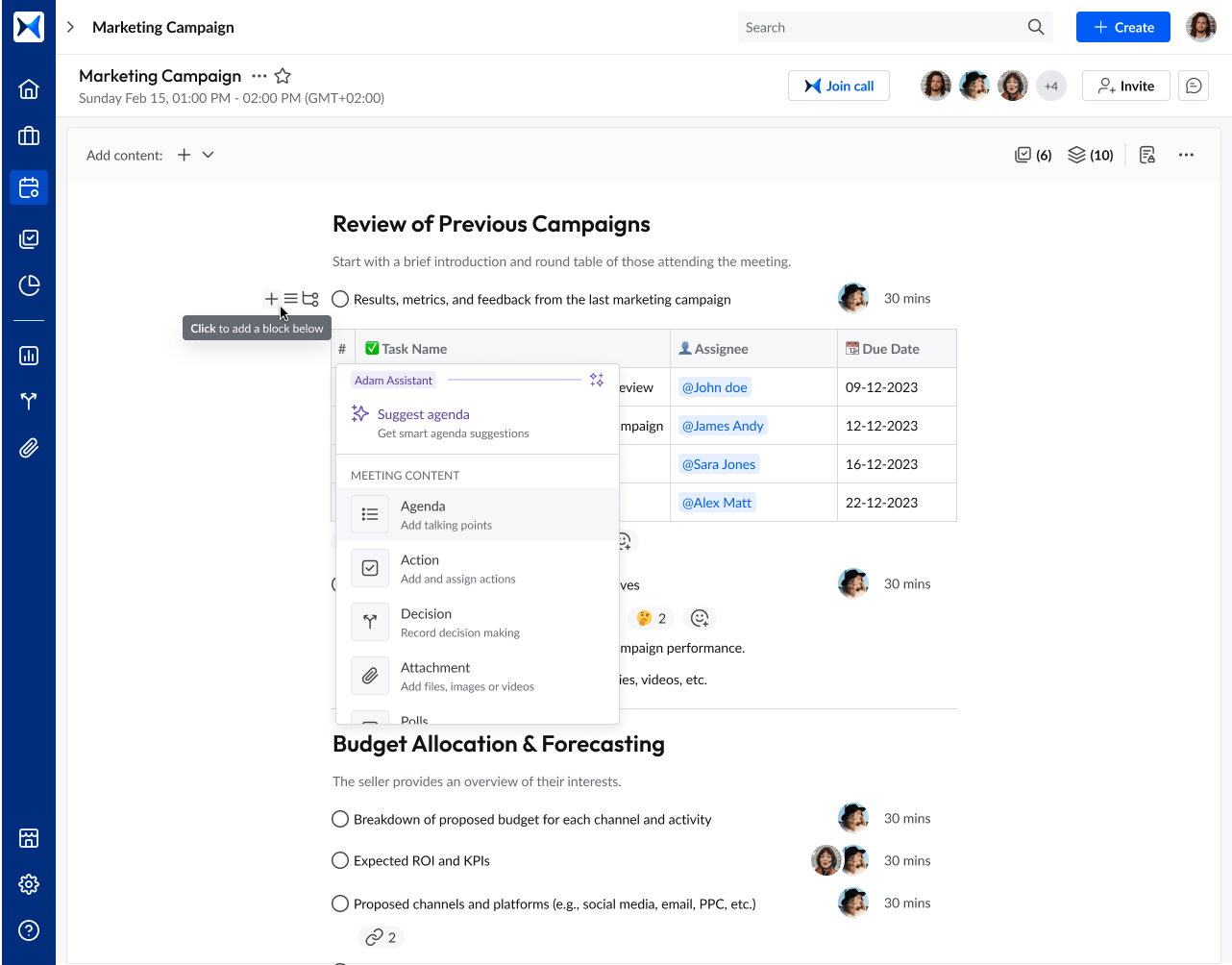
- Real-time content collaboration: Engage participants with interactive features like comments, mentions, and emoji reactions, fostering a collaborative environment where every voice is heard and every detail is noted.
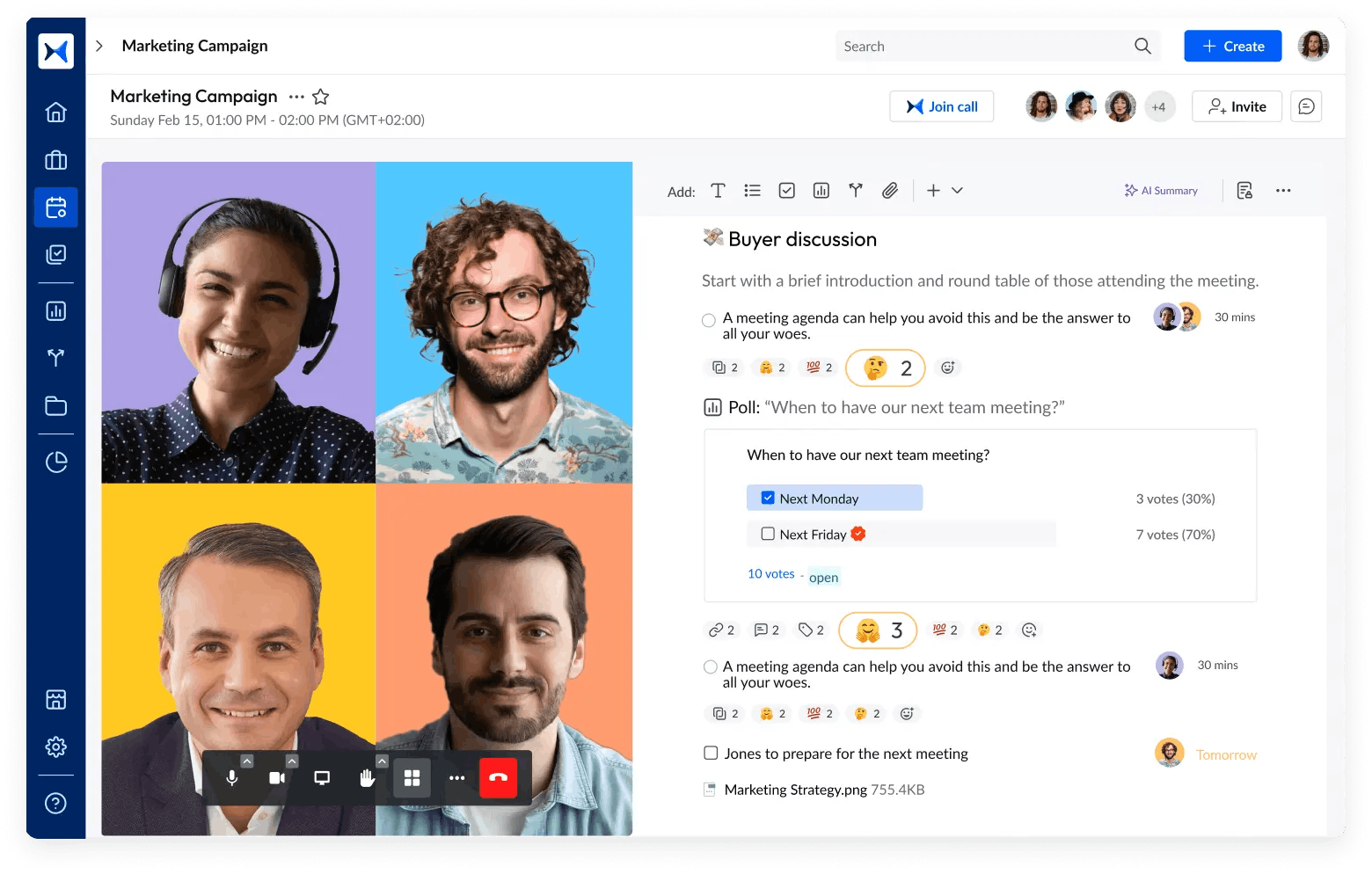
- Voting and polling: Conduct polls and voting during meetings to gather feedback and assign ownership for accountability, ensuring that decisions are made collectively and transparently.
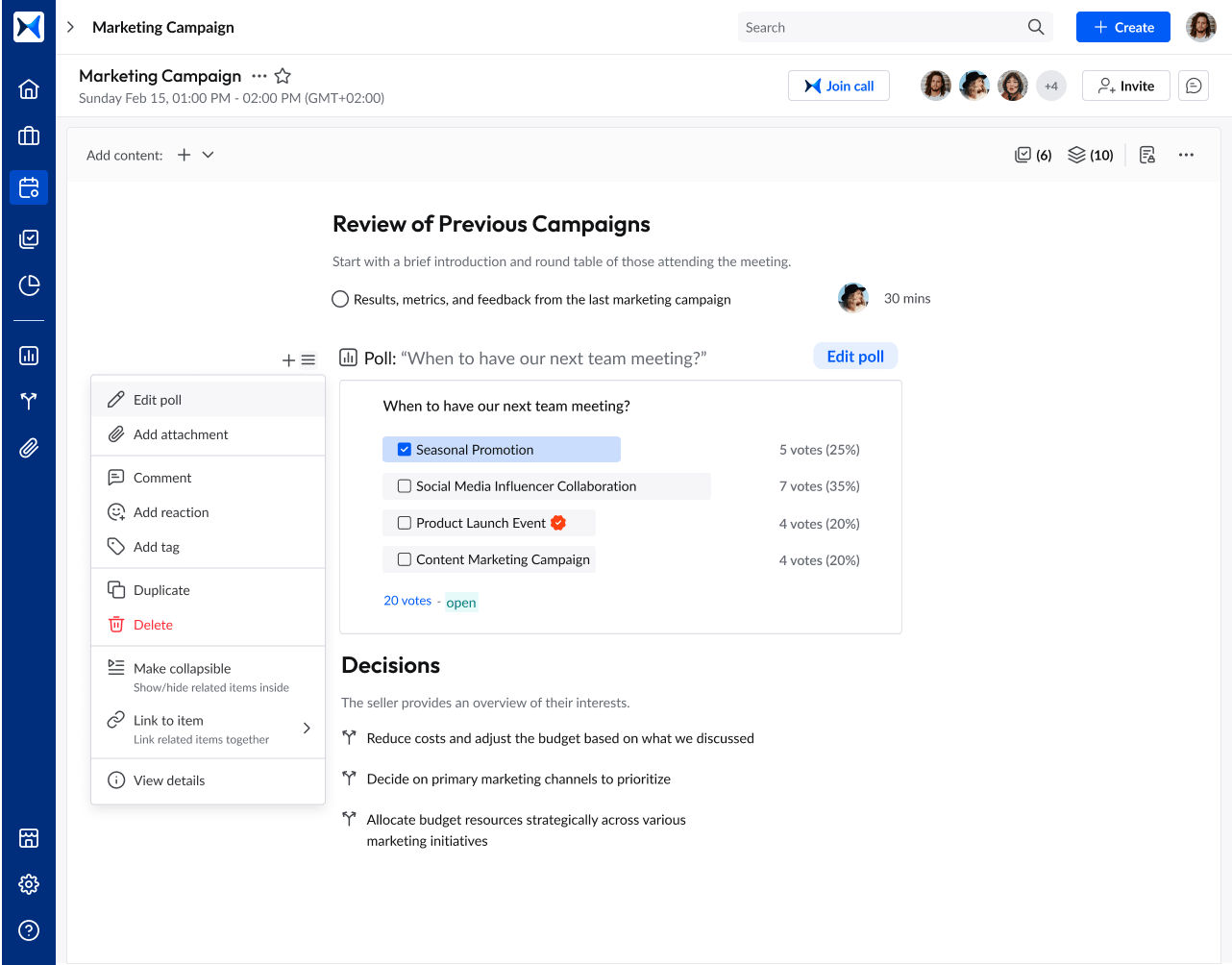
- Meeting minutes generation: Generate, comment on, and share meeting minutes with attendees and stakeholders, initiating an approval cycle for efficient review and finalization.
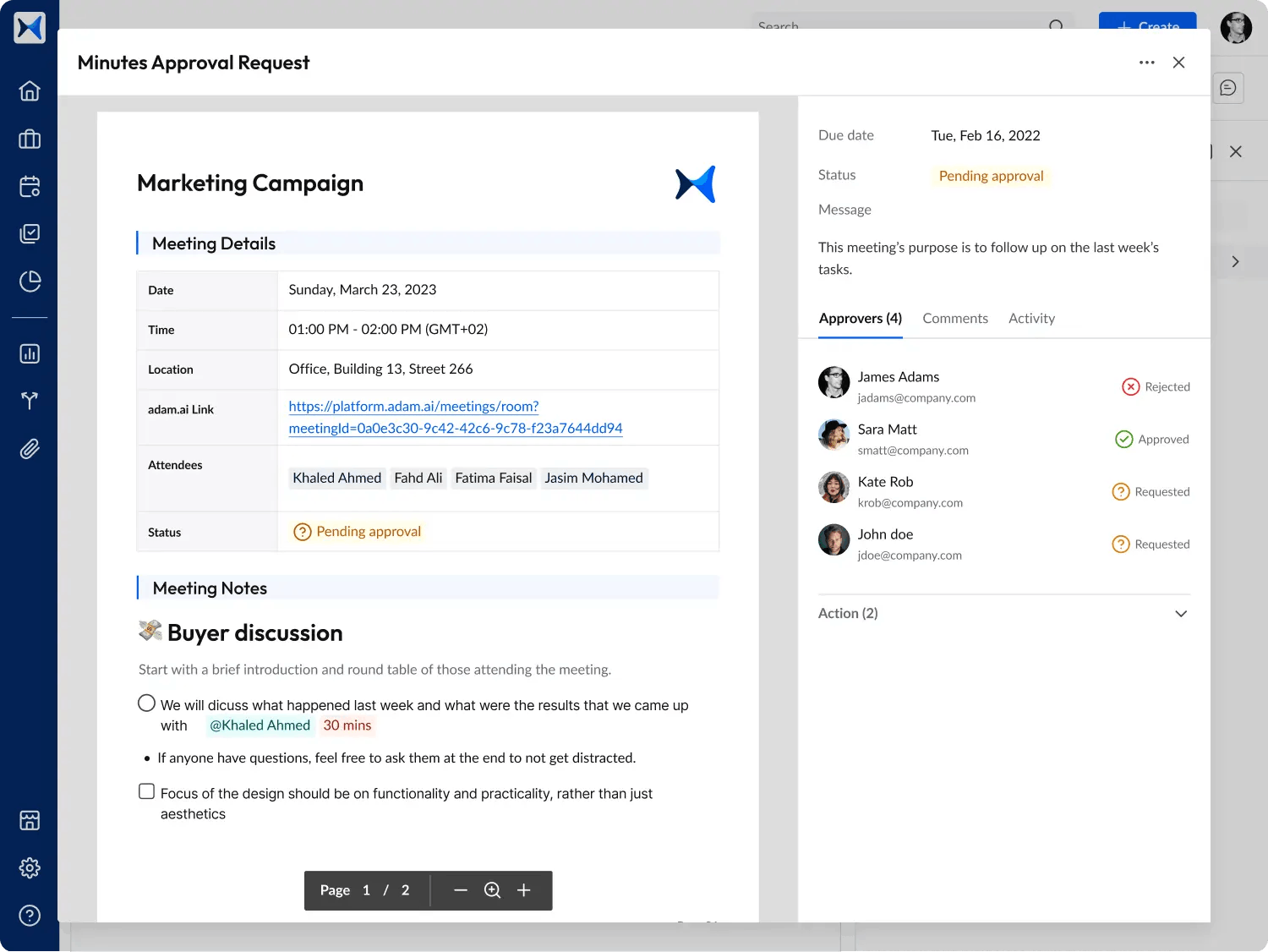
- Analytics dashboard: Gain insights into meeting performance across the organization, tracking key metrics, action completion rates, and overall progress to make data-driven decisions.
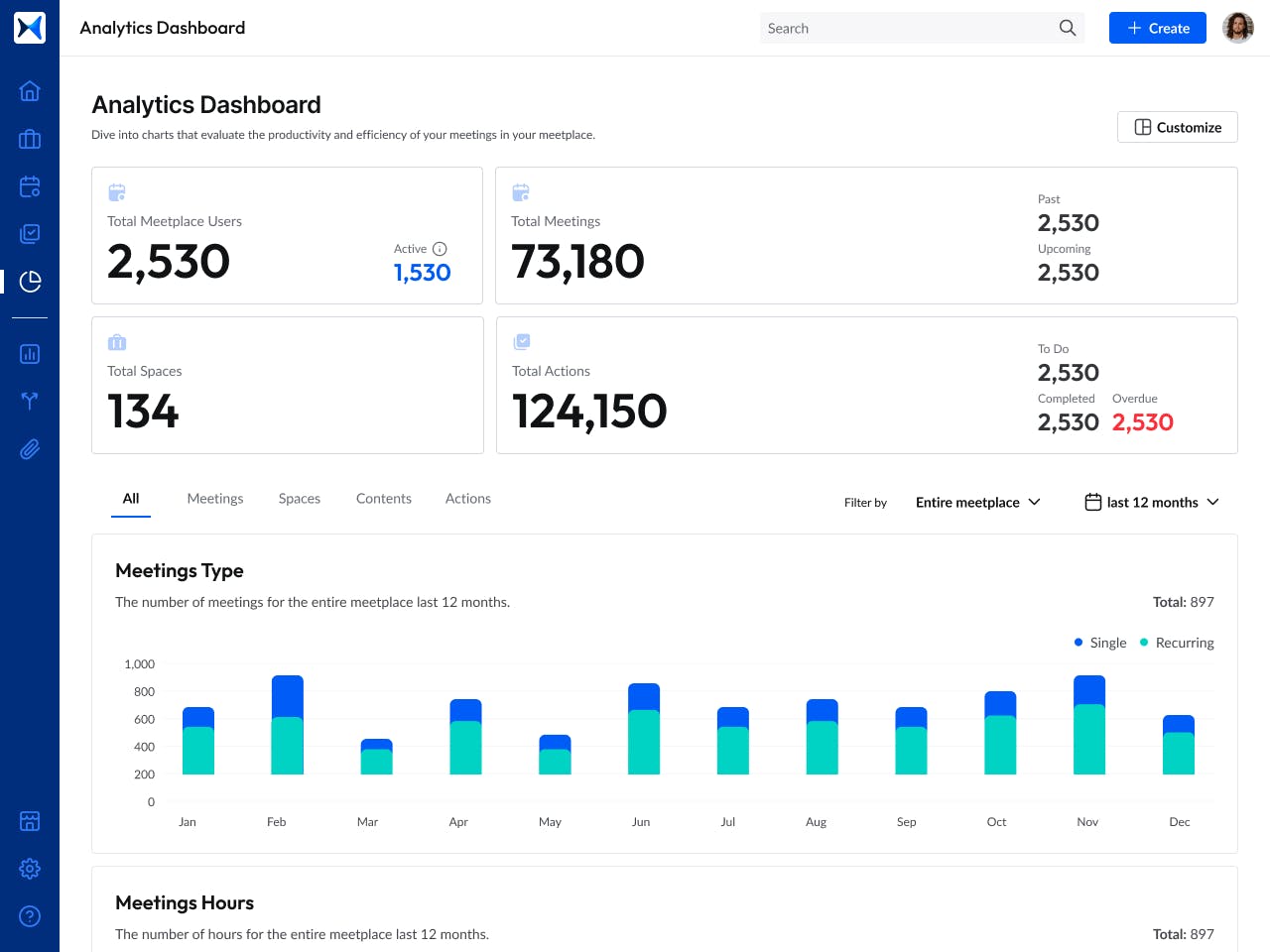
- Action management: Assign, delegate, and track actions with priority levels, descriptions, and attachments, monitoring the progress of tasks to ensure accountability and follow-through.
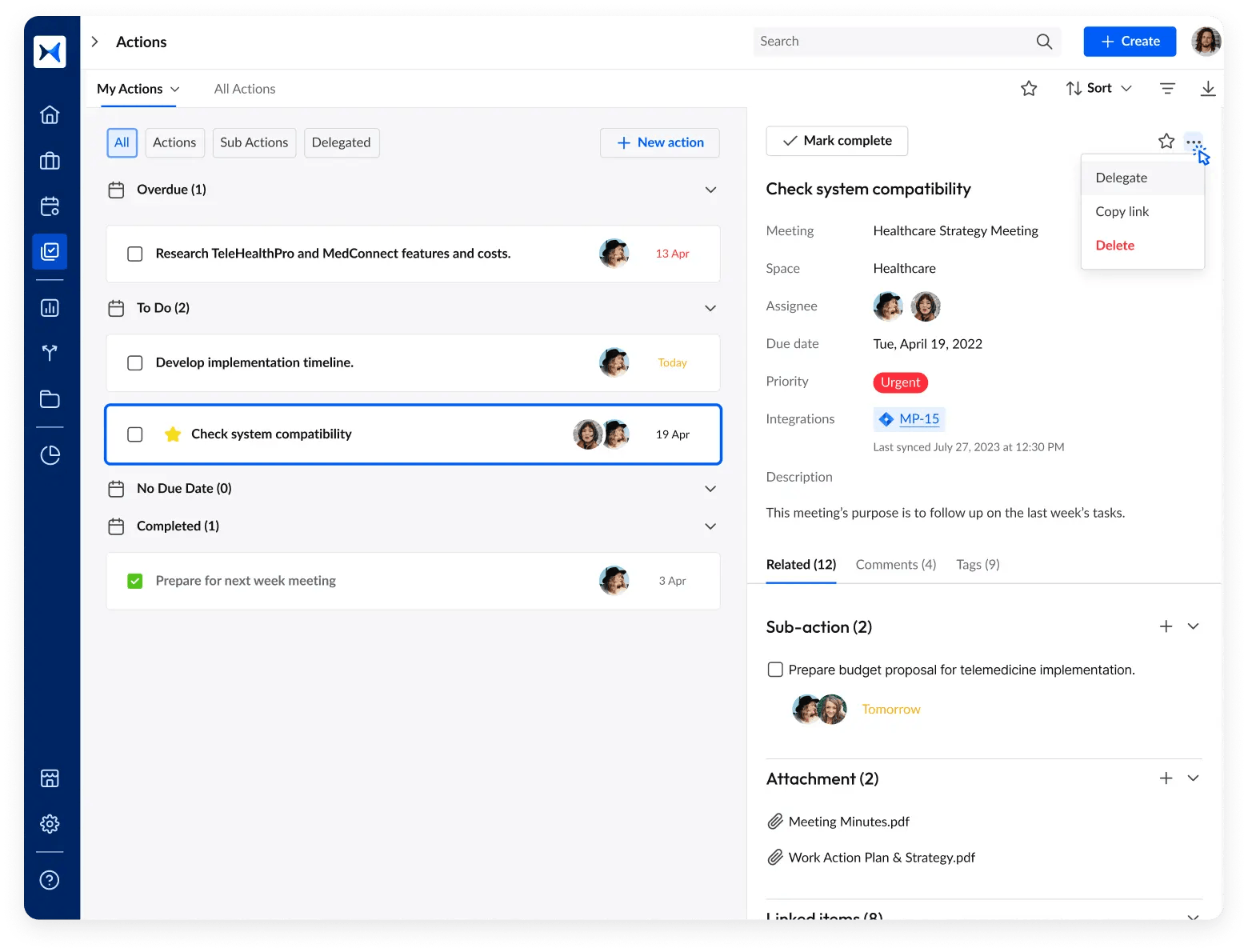
- Multi-space management: Organize meetings by projects, teams, committees, or boards, linking relevant meetings and content to maintain a clear overview and streamline collaboration.
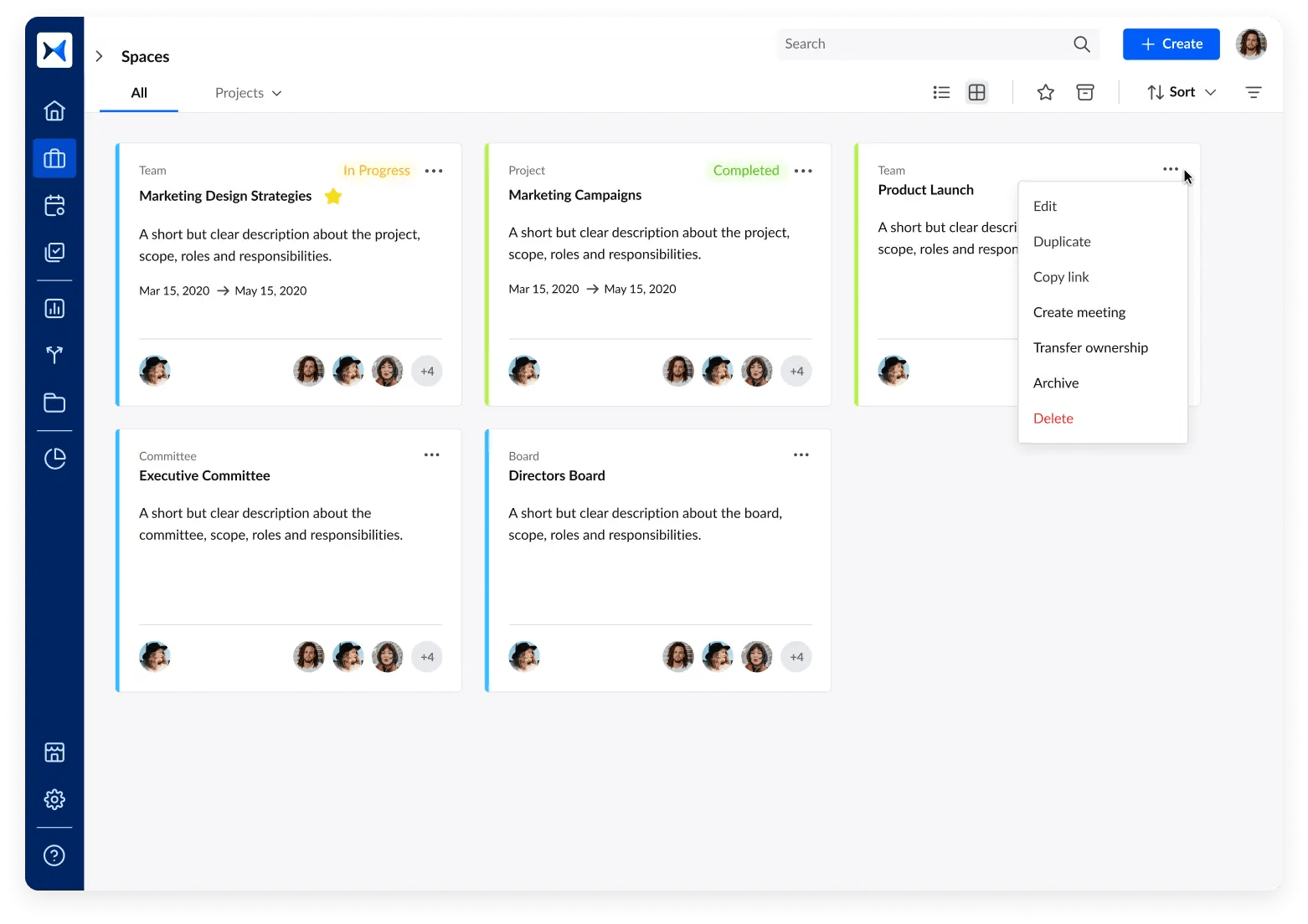
Transform how you conduct critical meetings—From meticulous preparation to effective execution and insightful follow-up, adam.ai integrates comprehensive analytics, full customization, and intuitive interfaces with powerful meeting management tools.
Easy onboarding. Enterprise-grade security. 24/7 dedicated support.
The bottom line
AI is redefining how faculty and administration collaborate, turning meetings into opportunities for alignment, innovation, and progress. By leveraging AI-driven tools, institutions can create a unified approach to education, ensuring everyone works together toward shared goals.
And while there may be multiple solutions available, here is why adam.ai is the meeting management software platform you can trust:
- adam.ai is one of Atlassian Ventures' portfolio companies.
- In the meeting management software category on G2, adam.ai has been ranked a leader and a high performer for successive quarters in the past years.
- adam.ai has been included in the Forrester Report in the AI-enabled meeting technology landscape.
- adam.ai is trusted and used by powerful teams and organizations worldwide for all types of critical meetings, like board, committee, project management, and business development meetings.
- And most importantly, adam.ai integrates with your existing workflow, is SOC2 compliant, provides dedicated support and success, and has a free trial option.
Subscribe to adam.ai blog
Stay ahead with the latest insights—get our newest blog posts, tips, and updates sent straight to your inbox.